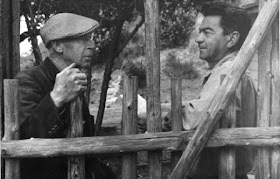It was a misty, rainy, day before Christmas driving down Highway 1 in Big Sur, California when we saw a big, hand-lettered sign saying, "Henry Miller Memorial Library. Free coffee and wifi." Why not stop? We parked, made our way up through the dripping trees, were welcomed by a young woman browsing the Internet and a cat. Inside the building, the one-time home of Miller's close friend Emil White (at right, with Miller, above) there were books (all kinds of books, not just Miller's work) for sale, busts of Miller, random letters, typewriters, and photographs.
It was a warm, cozy respite on a rainy day--but it made me want to find out more about this place that could have been a museum, or a historic house, but turned itself to something else, something more vital. Miller himself wasn't interested in memorials, saying "Memorials defeated the purpose of a man’s life. Only by living your own life to the full can you honor the memory of someone.”
The Library has an archival collection, well-preserved (and they have summer internships available) but the archives, the preservation, is only one tool in their arsenal of creating a memorial that's not really a memorial.
I was intrigued enough to buy the 2012 publication, Where Nothing Happens: The Best of the Henry Miller Memorial Library where I learned a bit more about the place, including Henry Miller's life in Highly Digestible Bullet Form and his life in Highly Digestible Paragraph Form. Different contributors talk vividly about the way that the library serves as the focus for the cultural life that's directly connected to the incredible Big Sur landscape continues to flourish. As Christopher Lorenc writes, the library "doesn't traffic in cliches about some bygone cultural era. It provides lifeblood for real, living, cutting-edge creative work right now."
Every historic house or museum is a memorial in some way or another, founded and continued by the desire to commemorate something or someone. But in far too many, we just look backward. Not every historic house can attract the Red Hot Chili Peppers, Neil Young or Laurie Andersen to play benefit concerts. But we can all look to the spirit of the place or people we commemorate for clues on how we might look forward ourselves. Were those homeowners of an early time risk-takers in business or industry? Why don't we encourage new innovations? Were they writers or artists or social reformers? Why not, like the Matilda Joslyn Gage House in upstate New York, take on today's tough conversations about reproductive rights? Were those early house dwellers just ordinary, you say? (really no one ever says that about their historic house inhabitants, even if they were). Why not embrace telling the stories of all sorts of everyday people with all the courage, determination, failure and success that implies?
If we want our museums and historic sites to be the lifeblood of our communities, we need to (paraphrasing Miller himself) live our organizational lives to the fullest. Now there's a New Year's resolution.






This comment has been removed by the author.
ReplyDeleteLinda, as always, you've given us something to think about. I think there are not enough places in my busy, urban life "where nothing happens." What a wonderful challenge to institutional thinking for museums to take their pasts and look forward!
ReplyDelete(Coincidentally, I just learned about Matilda Gage this past weekend at a get-together of L. Frank Baum and Oz enthusiasts. Gage was Baum's mother-in-law and played a big role in his involvement with women's rights long before it was fashionable or politically correct. Fascinating woman!)